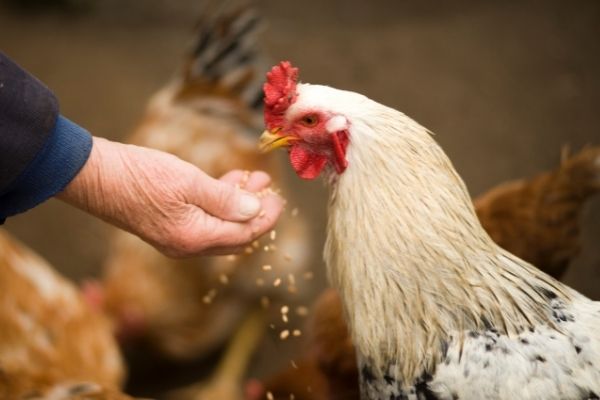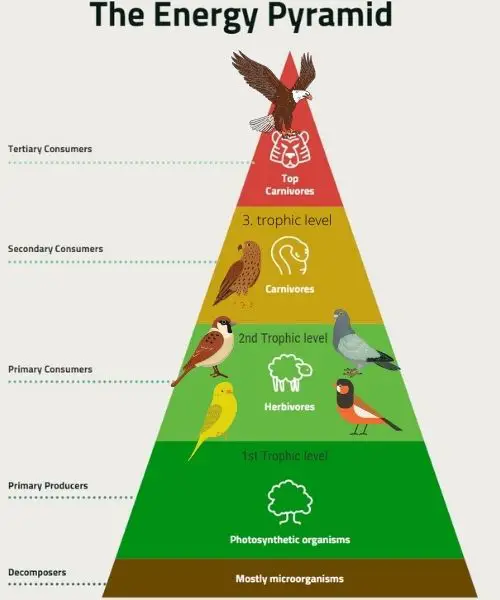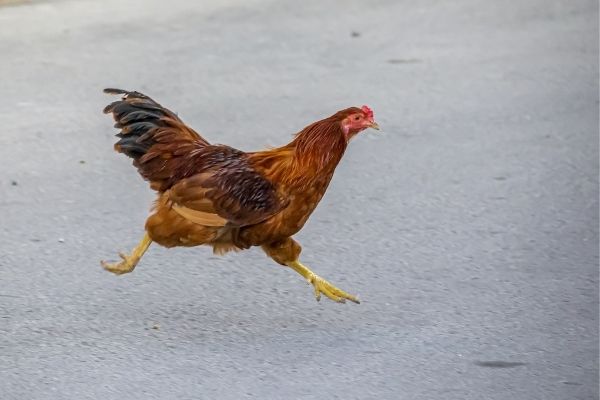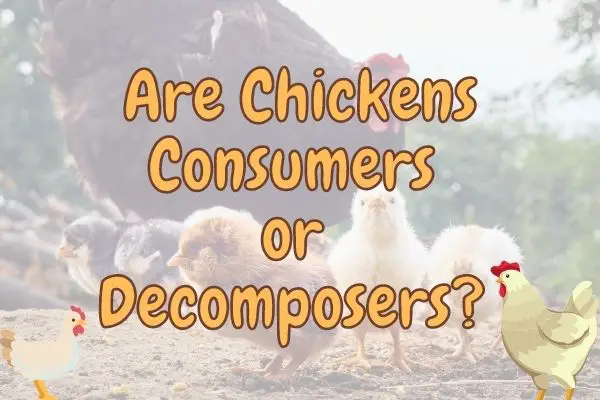Chickens are seen to eat both plants and animals. So, like humans they too are omnivores. Omnivores are the species of animals that can feed on plants and other animals and so do chickens.
In a typical food chain, they play an important role as secondary consumers since they feed on primary consumers like insects, worms, and other small animals in the wild. Hence, they are consumers.
Whereas chickens mostly survive on seeds, fruits, and leaves, they might also sometimes feed on dying or dead animals.
Chickens are known to be opportunistic feeders that will eat anything they can get. In the wild, they mainly eat seeds, fruits, leaves, insects, worms, and other small animals.
Their diet changes between seasons as different food types become more abundant or as they grow bigger and can digest larger food items like tadpoles, lizards and snakes.
Chickens are known to be the progeny of hens, they are important animals in the ecosystem because they play an important part in the food chain and also hold many economic importance.
As they are omnivores, they can feed on plants or animals or both, which helps to keep the population of both in check.
Chickens are also instrumental in helping spread seeds from the fruits and vegetables they eat, which helps to ensure that new plants can grow.
Contents
Are Chickens Carnivores, Herbivores or Omnivores?
Chickens are classified as omnivores. As omnivores, they have a flexible diet that includes both plant and animal matter.
Chickens are known to consume a wide range of food items, including seeds, grains, fruits, vegetables, insects, worms, small vertebrates, and even carrion or decaying organic matter.
In their natural habitat, chickens exhibit a diverse feeding behavior. They forage on the ground, pecking at vegetation such as grass, leaves, and fruits. They also scratch the soil to uncover insects, worms, and other small invertebrates. Chickens are opportunistic feeders and will consume whatever is available to them.
When domesticated, chickens are often provided with a balanced diet that includes commercially produced feeds, which typically consist of grains and plant-based ingredients.

However, even when given formulated feeds, chickens can still display their omnivorous nature by eagerly consuming insects or other small animals they encounter.
It’s important to note that the specific diet of a chicken can vary depending on factors such as its environment, availability of food sources, and the feeding practices implemented by humans. However, their biological adaptability and ability to efficiently utilize both plant and animal matter make them well-suited as omnivores.
Chickens are omnivores because they eat plants, insects and other animals. They have evolved to be able to digest plant matter as well as meat.
They eat a variety of things, including seeds, insects, worms, and plants and so take the position of secondary consumers, meaning that they can feed on primary consumers like insects and worms.
At the same time, they can feed on producers i.e. plants and so can be considered primary consumers too. Chickens are fed a high protein diet (including fish meal) and are fed to obtain meat, eggs, and feathers.
But chickens are also seasonal creatures and their diet will vary with the season, with the availability of insects and worms, and with the availability of other food (seeds, plants).
Are Chickens Producers, Consumers or Decomposers?
Chickens are primarily considered consumers in the context of ecological roles. They belong to the order Galliformes and the species Gallus gallus domesticus, which is the domesticated form of the red junglefowl (Gallus gallus).
As consumers, chickens are classified as omnivores, meaning they consume a varied diet that includes both plant and animal matter.
They have a diverse feeding behavior, foraging on seeds, insects, worms, small vertebrates, and vegetation such as grass, leaves, and fruits. Chickens also consume grains, making them important in agricultural systems for their ability to convert feed into protein-rich meat and eggs.
When chickens eat plants and animals, they obtain nutrients and energy from their food sources. They digest the consumed matter and convert it into energy for their own growth, reproduction, and maintenance. In this way, chickens act as consumers within the food chain.
However, it’s worth noting that chickens can also play a role as decomposers to some extent. When given the opportunity, chickens may scavenge and consume carcasses or decaying organic matter, aiding in decomposition processes. This behavior is more common in free-ranging or backyard chickens rather than commercially raised ones.
Regarding the evolution of chickens, their domestication can be traced back to the red junglefowl, which is native to Southeast Asia. Archaeological evidence suggests that humans began selectively breeding and domesticating red junglefowl for their meat and eggs over 8,000 years ago. Chickens were eventually introduced to other parts of the world and underwent further artificial selection, resulting in the various breeds we see today.
Archaeological records have revealed chicken bones at early human settlements, indicating their presence and consumption by humans throughout history. Additionally, genetic studies have provided insights into the evolutionary history of chickens and their relationship to other bird species.
In summary, chickens are primarily consumers, as they obtain energy and nutrients from a diverse diet consisting of both plant and animal matter. They play a vital role in agriculture as providers of meat and eggs. While they can also participate in decomposition processes by consuming decaying organic matter, their main ecological role is as consumers in the food chain.
What Type of Consumer is a Chicken?
Chickens are secondary consumers because they eat other consumers. But at the same time, they can also be called primary consumers as they can eat seeds and plant-based materials too.
Generally, herbivores are primary consumers, omnivores are secondary consumers and carnivores are tertiary consumers.
Chickens being omnivores, they are commonly considered to be secondary consumers in the food chain.
Are Chickens Decomposers?
No. Chickens do not eat dead or decaying matter and are therefore not decomposers.
However, they might feed on dead organic matter but won’t decompose it, which means that they are helping the decomposers in eliminating dead and decaying organic matter.
The bacteria in the gut of the chicken play a very important role in their digestion and these microorganisms are considered true decomposers.
Are Chickens Autotrophs or Heterotrophs?
Chickens are heterotrophs because they eat other living organisms and cannot prepare their own food. Practically no animals are autotrophic because animals are not capable of carrying out photosynthesis like plants do.
That is, animals like the chickens cannot make their own food or chemical energy, and need to deped on other organisms for energy and carbon source.
Where are Chickens in the Food Chain?
Chickens are secondary consumers because they eat other secondary consumers. The vast majority of a chicken’s diet is composed of small animals like earthworms, insects and slugs.
But they may also eat plants, corn, vegetables, seeds and grains and so can sometimes function as a primary consumer in some food chains.

Chickens occupy various positions in the food chain depending on their ecological context. Here’s an overview of their placement in different scenarios:
- Natural Ecosystems: In their natural habitats, such as forests or grasslands, chickens are consumers within the food chain. They are primary consumers, as they feed on plants, seeds, grass, leaves, and fruits. They also consume insects, worms, and other small invertebrates, making them secondary consumers in those instances.
- Agricultural Systems: In commercial agricultural systems, chickens are typically raised for meat and egg production. In this context, they are consumers that rely on specially formulated feeds consisting of grains, plant-based ingredients, and sometimes animal byproducts. The feeds provided to them are produced through primary production methods, such as farming or crop cultivation.
- Scavengers: Chickens can also play a role as scavengers within the food chain. In some settings, such as free-ranging or backyard systems, chickens may consume decaying organic matter, including carrion or kitchen scraps. By doing so, they aid in the decomposition process and contribute to nutrient recycling.
It’s important to note that the specific position of chickens in the food chain may vary depending on the particular ecosystem and the specific interactions with other organisms. Chickens can serve as a food source for predators such as foxes, snakes, or birds of prey, thereby occupying the role of prey or lower-level consumers in those instances.
Overall, chickens are versatile in their feeding habits, and their position in the food chain can differ based on their ecological context and the specific interactions with other organisms in their environment.
Chickens bring up the energy from plants and smaller animals through the food chain when eaten by larger predatory animals that are listed below.
What Animals Prey on Chickens?
Chickens are often food roaming around in open spaces and there are high chances they can become prey to certain animals.
They can be food for a variety of animals including opossums, foxes, raccoons, skunks, owls, mink, and weasels.
There are several animals that prey on chickens, both domestic and wild. Here are some common predators of chickens:
- Foxes: Foxes are known for their cunning and ability to dig under fences or sneak into coops to capture chickens.
- Coyotes: Coyotes are skilled hunters and can pose a significant threat to chickens, especially in rural areas.
- Dogs: Stray or feral dogs can attack and kill chickens if they have access to them. Even some pet dogs with a strong prey drive may pose a threat.
- Raccoons: Raccoons are nocturnal animals that are adept at opening latches and breaking into coops to prey on chickens.
- Hawks and owls: Birds of prey such as hawks and owls can swoop down from the sky and carry away chickens. They are particularly dangerous to free-ranging birds.
- Snakes: Some species of snakes, such as rat snakes or black racers, can enter chicken coops or nests and consume eggs or even kill young chicks.
- Weasels: Weasels are small, agile predators that can squeeze through small openings and kill chickens by biting their necks.
- Skunks: Skunks are opportunistic predators that may prey on chickens if given the chance.
- Bobcats and cougars: In rural areas or regions with a dense population of wild predators, larger predators like bobcats or cougars may pose a threat to chickens.
- Domestic cats: Free-roaming domestic cats can be a danger to chickens, especially young chicks.
It’s important to note that the effectiveness of predator control measures can vary depending on the location and the specific predator. Taking precautions like securing coops, using sturdy fencing, and keeping chickens confined during vulnerable times can help protect them from predators.
Conclusion
In this post, I have given you an overview of the food habits of chickens and the different types of food they eat.
To summarise, chickens are omnivores, meaning they can feed on plants as well as animals. They are a very common animal in the US and are often kept as pets, but they are also a very important part of the food chain in many ecosystems.
The role of chickens in the food chain is varied and complex, but they are important for many reasons.
They help to control pests, they help to maintain biodiversity and they are also important in the recycling of nutrients.

At the same time they are of economic importance as when they grow up to become hens they lay eggs and can be used as meat for human food.
Chickens are very popular pets and are often kept for their eggs, but they can also be kept as pets for their companionship.
If you would like to keep chickens as pets, you need to make sure they are happy and healthy and you should also make sure you have a good understanding of the natural habitats of chickens and the food chain.





